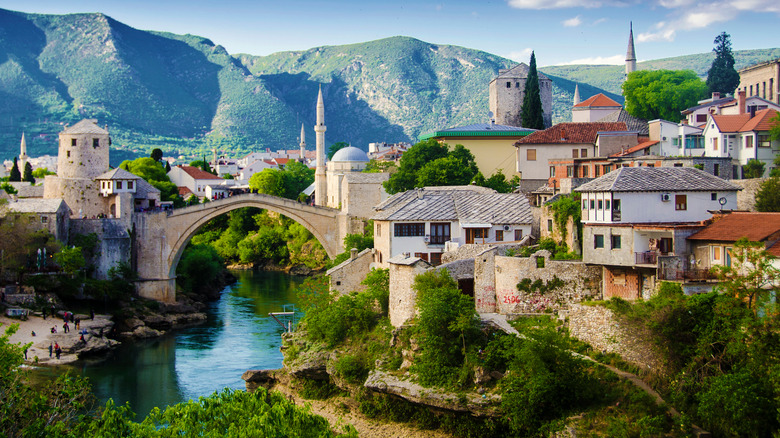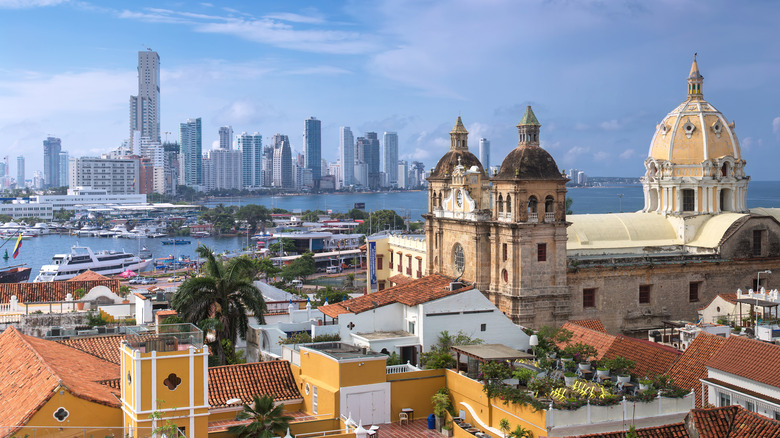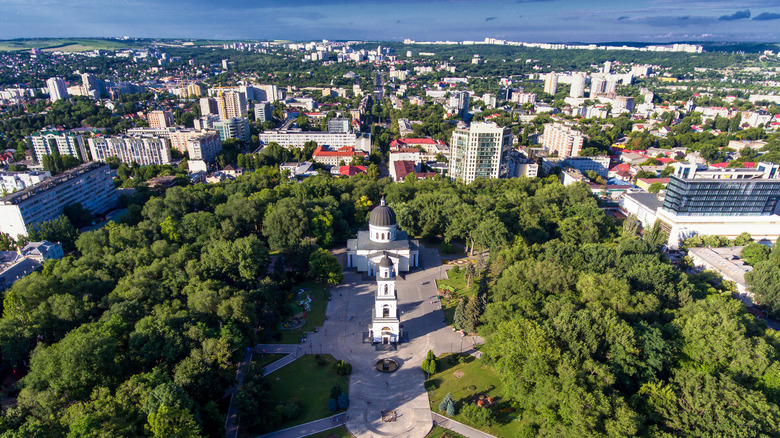Countries With The Highest Number Of COVID-19 Deaths
The COVID-19 pandemic has been nothing if not capricious. From its mysterious and often divergent symptoms to its spawning new and increasingly contagious variants to its seeming refusal to follow the rules of immunology, the pandemic continues to defy the expectations of both scientists and historians in new and increasingly incomprehensible ways. But one of the biggest puzzles regarding the COVID-19 pandemic is why it has hit some countries so much harder than others, particularly in terms of their relative per capita death rates. For example, as The New York Times points out, "Dominican Republic has reported nearly 7,600 cases of the virus. Just across the border, Haiti has recorded about 85. In Indonesia, thousands are believed to have died of the coronavirus. In nearby Malaysia, a strict lockdown has kept fatalities to about 100."
Even more puzzling, however, is that whereas underdeveloped nations typically shoulder the highest per capita deaths as a result of infectious disease, according to The New Yorker – which cites typhoid, malaria, and HIV as examples — with COVID-19, the highest per capita death rates are in the some of the more highly developed nations. This includes the U.S. and the U.K., which are 24th and 22nd in the world, despite the more advanced healthcare available in such nations. In fact, the countries with the highest numbers of COVID-19 deaths per capita are sure to surprise you. Let's have a look.
Peru
According to Johns Hopkins Coronavirus Resource Center, the South American nation Peru has the highest number of COVID-19 deaths per capita. With a population of over 32 million people (via Data Commons), Peru has had over 198,400 COVID-19 death as of September 6. That's around 610 deaths per 100,000 residents. Even taking into account that various countries count their COVID-19 deaths using their own standards, Peru can be seen as having had, thus far, the highest overall COVID-19 death toll in the world, according to the BBC. In addition to the highest per capita death rate, Peru is also dealing with a disturbingly high case-fatality rate of 9.2%. That makes Peru second only to Yemen (18.8%) in terms of the odds of dying from COVID-19 if diagnosed.
So, why would it be that a Peruvian's odds of both getting COVID-19 AND dying from it are higher than virtually anywhere else in the world (i.e., except Yemen)? The reasons may include the slow vaccine rollout (as of June 1, a mere 4% of Peru's population had been fully vaccinated; as of today, it's up to just 26.13%, according to Johns Hopkins). In addition, Peru's healthcare system — which is lacking in funding, according to experts (via BBC) — has been operating with a shortage of medically administered oxygen and a dearth of intensive care beds.
Hungary
While Hungary is doing better than Peru at keeping its residents alive during the pandemic, it nevertheless has the second highest number of per capita COVID-19 deaths, according to Johns Hopkins Coronavirus Resource Center. According to the latest numbers, Hungary has recorded over 30,000 COVID-19 deaths among its population of 9.7 million people (via Data Commons). That translates to around 307 deaths per 100,000 people. And this is despite the fact that Hungary has had a decent response to its vaccine program; as of September 6, an estimated 55.58% of Hungary's population had been fully vaccinated against COVID-19 (via Johns Hopkins). So what exactly is going on with Hungary that would make its per capita death rate the second highest in the world?
According to the journal BMJ, Hungary's government made the decision to lift lockdown restrictions in full as of June 16...2020. Although this decision didn't have an immediate impact on Hungary's COVID-19 death count, when coupled with the fact that Hungary's healthcare system has been poorly managed for more than a decade, the scene was set. This may also help to explain why the case-fatality rate in Hungary (3.7%) is also higher than many other countries.
Bosnia and Herzegovina
Right behind Hungary, Bosnia and Herzegovina has the third highest number of COVID-19 deaths per capita, according to the Johns Hopkins Coronavirus Resource Center. Bosnia and Herzegovina has recorded over 9,900 COVID-19 deaths among its over 3.3 million residents since the start of the pandemic (via Data Commons). That translates to a per capita death rate due to COVID-19 of around 298 per 100,000 persons. This might not be all that surprising when you consider that a mere 10.93% of the residents of this Balkan nation have been fully vaccinated as of September 6 (via Johns Hopkins). Accordingly, and perhaps not surprisingly, Bosnia and Herzegovina also has the highest rate of cases and raw number of deaths (not adjusted per capita) in the Western Balkans (via International Bureau).
The relatively low vaccination rate in Bosnia and Herzegovina may also be impacting the nation's relatively high case-fatality rate of 4.6%. Bosnia and Herzegovina's 9,900+ deaths from COVID-19 resulted from a total of more than 216,000 confirmed COVID-19 cases. That said, it may not be fair to blame the people of Bosnia and Herzegovina for their country's unimpressive vaccination numbers, according to Al Jazeera, which explained that the country had ordered millions of vaccine doses but as of March 2021 hadn't received most of them.
North Macedonia
North Macedonia, which has roughly 2.1 million residents (via Data Commons) has had over 6,000 deaths from confirmed cases of COVID-19 (via Johns Hopkins Coronavirus Resource Center). As such, this southeastern European nation has a per capita death rate due to COVID-19 of around 291 deaths per 100,000 persons. With total confirmed cases at over 180,000 as of September 6, the case-fatality ratio is also on the high side, at 3.4%.
While we can't say for sure what is at the heart of North Macedonia's relatively high COVID-19 death rate compared to other countries, perhaps this news release dated May 28, 2020 from the North Macedonian government can shed at least a bit of light: "As of today, the Decision on prohibition and the special regime of movement of the citizens on the territory of the Republic of North Macedonia ceases to be valid." In other words, whereas Hungary had seemed a bit hasty in terminating COVID-19-related restrictions in July 2020 (via BMJ), North Macedonia had Hungary beat by at least two weeks. Nor is North Macedonia's vaccination program particularly successful — just 25.87% of the population is fully vaccinated (via Johns Hopkins). And things may only be getting worse with the recent announcement by the North Macedonian government that, notwithstanding rising COVID-19 numbers, the national census would proceed as planned on Sunday, September 3.
Czechia
Czechia has thus far recorded the deaths of over 30,400 people as a result of COVID-19 (via Johns Hopkins Coronavirus Resource Center). That means that the former Eastern portion of Czechoslovakia has the sixth highest number of COVID-19 deaths per capita, with around 285 deaths per 100,000 of its 10.7+ million residents (via Data Commons). However, it's worth noting that Czechia's per-case fatality rate is significantly lower than that of the four other countries with the highest number of COVID-19 deaths per capita (Peru, Hungary, Bosnia and Herzegovinia, and North Macedonia, respectively). The 30,400+ people who have died from COVID-19 in Czechia came from over 1,680,500 confirmed cases, translating to a case-fatality rate of 1.9%.
Czechia's case-fatality rate of 1.9% puts it in the same general position as the U.K. with regard to one's odds of dying from COVID-19 after contracting it (via Johns Hopkins Coronavirus Resource Center). Yet the U.K. has a per capita death rate well below that of Czechia — of around 200 deaths per 100,000 residents. In other words, Czechian residents, with or without an active COVID-19 infection at this moment, are statistically more likely to die from COVID-19 than residents of the U.K. — despite that as of September 6, more than 54% of Czechia's residents have been fully vaccinated (via Johns Hopkins). The BBC cites what it considers to be the Czechia government's lack of zeal in following, let alone enforcing, its own pandemic-related restrictions.
Montenegro
"As the COVID-19 pandemic began spreading in Europe in March [2020], the Montenegrin government took swift and decisive measures to contain the virus, including by closing its borders, airports, seaports, schools, and non-essential businesses," according to the International Monetary Fund (IMF). Nevertheless, as of September 6, 2021, the relatively small nation of Montenegro, which has a population of about 628,000 (via Data Commons) has had 1,700+ deaths from COVID-19, according to the Johns Hopkins Coronavirus Resource Center. That puts Montenegro's number of COVID-19 deaths at around 282 per 100,000 people. That is the sixth highest number of COVID-19 deaths, per capita, in the world. Nevertheless, the good news for residents of Montenegro is that those who contract COVID-19 are far less likely to die from it than those in any of the five countries with higher COVID-19 deaths on a per capita basis.
Montenegro, which has vaccinated 30.41% of its population (via Johns Hopkins), has had nearly 118,500 confirmed cases of COVID-19. That means its 1,700+ deaths from COVID-19 represent just 1.5% of cases. Now, compare that with Peru, whose deaths per 100,000 persons represent 9.2% of all COVID-19 cases there. Although a 1.5% fatality rate is still troublesome, it's worth noting that it's actually slightly better than the current per case fatality rate in the U.S. of 1.6%. And this is despite the fact that 53.61% of the U.S. population has been vaccinated against COVID-19 (via Johns Hopkins). Could Montenegro's social distancing program be paying off (via Garda)?
Brazil
On September 6, South America's largest nation, Brazil, had recorded a total of nearly 21,000,000 confirmed cases of COVID-19 since the beginning of the pandemic (per Johns Hopkins Coronavirus Resource Center). Of those, 538,000+ have resulted in death. Although in recent weeks, COVID-19 cases in Brazil have decreased by 28% and related deaths have decreased by 21%, according to The New York Times, the country nevertheless remains among the top 10 nations in the world with regard to COVID-19 deaths per capita. In fact, Brazil currently stands as seventh in the world, with around 276 deaths per 100,000, out of roughly 211 million residents (via Data Commons). Putting it another way, roughly one in 362 people in Brazil has died from a confirmed case of COVID-19, and around one in every 10 people in Brazil has had a confirmed case. And looking at it from the per-case fatality standpoint, the odds of dying from COVID-19 in Brazil stand at 2.8%.
So, what are the factors contributing to Brazil's high rate of COVID-19 deaths in the population? To some extent, it may be attributable to Brazil's lackluster vaccination rate. Just 31.53% of Brazilian residents have been full vaccinated as of September 6 (via Johns Hopkins). In addition, high-ranking members of the government — including its president, Jair Bolsonaro — have "scorned" the virus even as they exposed themselves to it and contracted it themselves (via The New York Times).
Bulgaria
Right behind Brazil in terms of its per capita rate of death from COVID-19 is the Eastern European nation of Bulgaria (via Johns Hopkins Coronavirus Resource Center). With a population of around 7 million (via Data Commons), there have been over 19,000 deaths from COVID-19 as of September 6. That means that for every 100,000 people who reside in Bulgaria, around 274 have died from COVID-19. Since that is out of 462,000+ confirmed cases, the chances of a Bulgarian resident dying of a confirmed case of COVID-19 is 4.1%. That puts it on a par with Bolivia and Myanmar, both of which have a current per-case fatality ratio of 3.8%. And the fact that public health experts agree that Bulgaria's numbers are "definitely an undercount" due to a lack of affordable testing makes these numbers only more alarming. That Bulgaria has managed to fully vaccinate a mere 17.20% of its population cannot be helping (via Johns Hopkins).
In a recent interview, Bulgaria's Health Minister Stoycho Katsarov attributed Bulgaria's low vaccination rate in part to his own countrymen's "susceptibility to conspiracy theories," according to France 24. And media expert Nelly Ognyanova believes that the media itself is partly to blame for the "poor standard of information." She said to France 24, "The media, the social networks, the public appearances of experts and other sources carry shared responsibility for anti-vaxxer sentiment and for mistrust about the role and safety of vaccines."
San Marino
A small republic located entirely within the nation of Italy, San Marino would appear to be boasting some rather astonishing numbers. On the one hand, more than 70% of San Marino residents having been fully vaccinated (via Johns Hopkins), and since the start of the pandemic, San Marino has counted just 90 deaths due to COVID-19. However, considering San Marino's population hovers at just around 34,000 residents (via Data Commons), that's a relatively high per capita number. Specifically, according to the Johns Hopkins Coronavirus Resource Center, if San Marino had 100,000 residents, the number of deaths per 100,000 would be 265.80. That is why San Marino ranks eighth in the world for per capita COVID-19 deaths, despite its favorable vaccination rate.
Nevertheless, San Marino's per-case fatality rate (90 deaths per 5,345 cases) is just 1.7%. That puts San Marino on a par with Czechia, Montenegro, and the U.S. in terms of its residents' statistical prognosis in the event of contracting COVID-19. Interestingly, neither Czechia, Montenegro, nor the U.S. has anywhere close to San Marino's vaccination rate. Similarly, Italy's per-case fatality rate is a full percentage point higher than that of San Marino (2.8%) despite having vaccinated 62% of its population (via Johns Hopkins), which is a significantly higher vaccination rate than that of Czechia, Montenegro, or the U.S. While this could seem head-scratching, these numbers can perhaps be explained by the early surge of the virus in Italy, which was the first Western nation to see a large spike in cases and deaths, prior to the availability of vaccines (via The Conversation and Advisory Board).
Argentina
Argentina has the tenth highest per capita death rate from COVID-19 in the world and the third highest on the South American continent, behind Peru and Brazil (via Johns Hopkins Coronavirus Resource Center). Of the nearly 45,000 million residents of Argentina (via Data Commons), 112,500+ have died from COVID-19 since the beginning of the pandemic. That means that for every 100,000 people living in Argentina, 250 have died of COVID-19. Nevertheless, Argentina's residents do not face nearly the risk of death in the event that they do contract COVID-19 as their peers in Peru, where the per-case fatality rate is 9.25%.
Argentina's 112,500+ deaths were counted among 5,207,000+ confirmed COVID-19 cases, putting Argentina's per-case fatality rate at a middling 2.2%. This might be attributable, to some extent, to Argentina's having a higher vaccination rate (35.81% via Johns Hopkins) than Peru (26.13% via Johns Hopkins). Argentina's per-case fatality rate is also lower than Brazil's (2.8%), but not by nearly as much. That being said, Argentina's vaccination rate is not much higher than that of Brazil's, which is currently at 31.53%, according to Johns Hopkins.
Colombia
Falling in line right behind Argentina in terms of its number of COVID-19 deaths per capita is its South American neighbor, Colombia (via Johns Hopkins Coronavirus Resource Center). With a population of over 50 million (via Data Commons), Colombia has confirmed 125,200+ deaths due to COVID-19. That translates to just over 248 deaths per 100,000 residents, compared with just over 250 in the case of Argentina. Statistically speaking, this difference is not particularly significant. And in a slight reversal, Colombia's per case fatality rate of 2.5% actually stands at just slightly HIGHER than Argentina's (2.2%). Accordingly, from these numbers alone, it's difficult to ascertain which country has a higher number of COVID-19 deaths.
For what it's worth, Colombia does have a slightly lower vaccination rate than Argentina. Whereas 29.55% of Colombian residents have been fully vaccinated as of September 6 (via Johns Hopkins), 35.81% of Argentina's residents have been fully vaccinated as of the same date (via Johns Hopkins). For now, it appears that the two South American nations are essentially neck and neck in terms of their respective numbers of COVID-19 deaths. And both Colombia and Argentina are currently enjoying significantly decreased confirmed case counts and deaths, according to Reuters.
Moldova
The European nation of Moldova, which was formerly a member of the Soviet Republic, has recorded over 6,400 deaths due to COVID-19 (via Johns Hopkins Coronavirus Resource Center) among its roughly 2.6 million residents, as of September 6 (via Data Commons). This translates to about 242 deaths due to COVID-19 for every 100,000 residents. Accordingly, Moldova currently ranks at twelfth in the world for COVID-19 deaths per capita. Having recorded, thus far, a total of more than 270,000 confirmed COVID-19 cases, Moldova's 6,400+ COVID-19 deaths represent a case-fatality rate of 2.4%. A couple elements could account for this high rate. Like both Hungary and North Macedonia, Moldova scaled back COVID-19 restrictions at an early stage — at the end of June 2020 (via Balkan Insight). And as one of Europe's poorest countries, Moldova also struggled to procure vaccines, eventually receiving donated doses in March 2021 (via Reuters).
Yemen
Yemen has recorded a "mere" 1,523 COVID-19 deaths (via Johns Hopkins Coronavirus Resource Center) among its more than 29,161,922 residents (via Data Commons). That translates to just 5 deaths for every 100,000 people, which affords Yemen the distinction of NOT being among the countries with the highest COVID-19 deaths per capita. In fact, Yemen's per capita COVID-19 death rate is among the lowest in the world. However, we feel obliged to include Yemen here among the countries with the most COVID-19 deaths because, despite the fact that relatively few people in Yemen have died from COVID-19, many in Yemen who have contracted COVID-19 have died.
Specifically, Yemen's 1,523 deaths from COVID-19 represent 18.8% of Yemen's total number of confirmed COVID-19 cases, of which there were 8,108 as of September 6. In other words, the chances of contracting COVID-19 in Yemen are not actually all that high on either a raw or a per capita basis; however, people in Yemen who test positive for COVID-19 are far more in danger of dying from COVID-19 than people anywhere else in the world. This is likely due to a combination of factors: the war-torn nation's floundering healthcare system, additional health crises such as malnutrition and cholera outbreaks, and a dearth of healthcare workers, among other reasons (via BMJ). And currently, Yemen's COVID-19 confirmed case count is on the rise, with 44 new infections being reported every day, on average, according to Reuters. Not surprisingly, the number of COVID-19 deaths in Yemen is rising precipitously. Making matters worse, Yemen has administered a mere 311,483 doses of COVID vaccines thus far, which is not even enough to have fully vaccinated one percent of the country's population.













